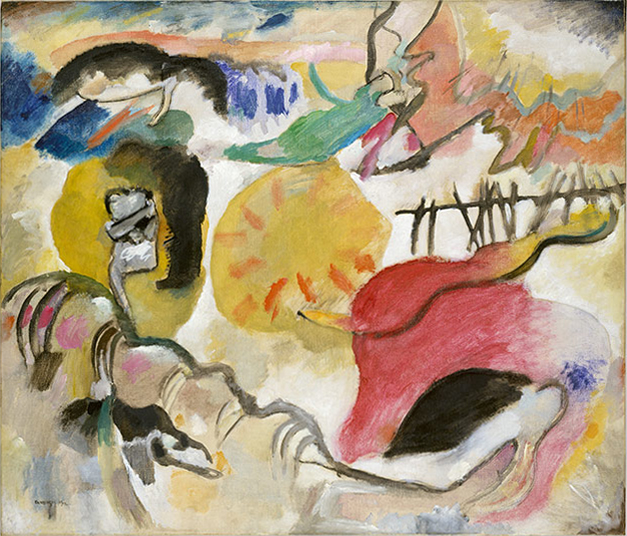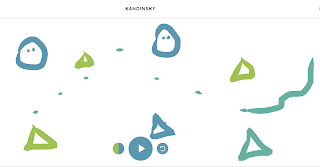**This post contains affiliate links and I will be compensated if you make a purchase after clicking on my links. I only recommend products that I know and love.
Have you already discovered the book The Noisy Paintbox by Barb Rosenstock? What potential for a marvelous cross-curricular lesson! Wassily Kandinsky was an important 20th century artist and is known as one of the first to create abstract art. He was a Russian artist who experienced sounds as colors and colors as sounds. How interesting!
____
Here is a kid-friendly page with more facts on Kandinsky's life, including images of his most important paintings.
Cross-Curricular Connections
My favorite arts integration topics follow the natural connections between subjects. Here are some of the connections to explore through the book, The Noisy Paintbox.
- Social Studies: coordinate with the grade level that would be studying time period of Kandinsky's most famous works - the early 20th century. In my school, this was a 5th grade topic of study.
- Art: Several of my art teacher colleagues have used Kandinsky in their study of line & shape. Because music also has line & shape, this is a great connection.
- Reading: There is a well-established value to reading books aloud to children. The fluency & expression that we model as we read is so important. This book can demonstrate (without really lecturing about it) the concept of reading to learn. What can we learn about Kandinsky from this book?
- Vocabulary: There are some words in the book that might not be familiar to elementary students. Most notably, the color words like vermillion, coral, cobalt and saffron, and the music terms like improvisation, composition, and accompaniment. Take the time to show the colors (even point to them in the book) and define or review the music terms.
- Emotions: "Art should make you FEEL, like music." This is a great way to discuss feelings, both how a painting or piece of music make us feel and how we can express our own feelings through art and music.
- Self Confidence: As the story in the book goes, Kandinsky was respectful of his family and elders and learned the traditional school subjects and traditional painting styles. When he knew inside himself that there was more, he was not afraid to stand up and try new things.
Music Lesson Ideas
READ the book aloud to your students or use one of the read aloud videos on YouTube. In my own practice, I really like to have the physical book in my hands, even if I choose to use a YouTube read aloud. Discuss Kandinsky's life and art. Incorporate some of the cross-curricular suggestions above into your discussion.
LOOK at one or more of Kandinsky's abstract artworks. Discuss the lines & shapes & colors. Ask the students how the artwork makes them FEEL.
%2C_oil_on_canvas%2C_94_x_130_cm%2C_Museum_Boijmans_Van_Beuningen.jpg/800px-Wassily_Kandinsky%2C_1911%2C_Reiter_(Lyrishes)%2C_oil_on_canvas%2C_94_x_130_cm%2C_Museum_Boijmans_Van_Beuningen.jpg) |
| Lyrical, 1911 |
 |
| Improvisation 27, 1912 |
LISTEN to a musical selection that will evoke FEELINGS. Ask students to listen with eyes closed for a minute or two. Then, discuss how the music made students feel and what they might have seen in their minds as the music was playing. For this listening activity, I prefer to use music without lyrics as I don't want the lyrics to influence the students as they ponder how the music makes them feel. Here are a few suggestions, ut know that the possibilities are endless!
- Happy: Any Strauss waltz, Mozart-Eine Kleine Nachtmusik, Vivaldi-Spring from The Four Seasons, Holst-Jupiter from The Planets, Passport-Daybreak Delight, Songs of Water-Everything that Rises
- Excited: Mussorgsky-Night on Bald Mountain, Mozart-Symphony No 40, Bob James-Night on Bald Mountain
- Bold, Brave: Dvorak-Symphony No. 9 Finale, Tchaikovsky-Symphony No. 4 Finale, Bob James-Farandole
- Peaceful: Chopin-Nocturne Op. 9 No. 2, Beethoven-Moonlight Sonata, George Benson-Lady, Chick Corea-Children's Song
DRAW your feelings. Pass out blank paper and crayons and give students a chance to draw while the music plays again.
CREATE. Optional: follow up with this technology integration: allow students to create picture compositions in Chrome Music Lab's Kandinsky app.
Connections Make Us Stronger
Another important realization for me was remembering that my students were also the classroom teachers' students. We share them! For this reason, connecting with other subjects helps us connect with our students.
I encourage you to take some time to look for meaningful connections with the other subjects for the benefit of all our students. Figure out when would be the best grade level or time of year to teach that lesson to coordinate with another subject.

.png)


.png)
.png)










.png)

0 Comments:
Post a Comment